Mount Athos is known as the “Garden of the Virgin Mary”, as the place where she appears, acts and rests, as "the conceivable and most beautiful Paradise of Theotokos". Many miraculous icons of the Virgin Mary are kept in this place, which still perform countless miracles until today. Some of the miraculous icons of the Virgin Mary found on Mount Athos are Virgin Pantanassa, Virgin Mary Portaitissa, Virgin Mary Three-handed Tricherousa, Virgin Gorgoepikoos, Virgin Glykofilousa, Panagia Galaktotrophousa - the Virgin Lactans or Milk-nursing, Panagia Hodigitria, Panagia Myrovlytissa, Panagia Axion Esti, Panagia Epakoousa, Panagia Gerontissa, Virgin Mary the Formidable Protection, Panagia Paramythia, Theotokos Economissa or Stewardess, Panagia Koukouzelissa, Virgin Mary Slaughtered Esphagmeni, Panagia Ktitorissa Vimatarissa, Panagia Cherovo. In the following articles you will find information about the history of the miraculous icons, as well as images of the holy icons.
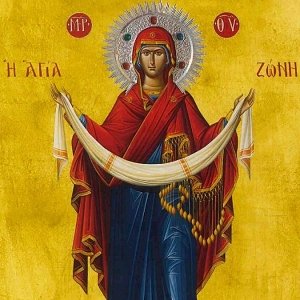
The power of the Sacred Belt of Theotokos is great and miraculous. It preserves the grace of the Virgin Mary, sanctifies the faithful and frees them from sorrows and diseases. The Holy Belt has performed innumerable miracles, especially in cases of women who had difficulty conceiving children. A ribbon sanctified by the Agia Zoni helps women to have a good pregnancy.
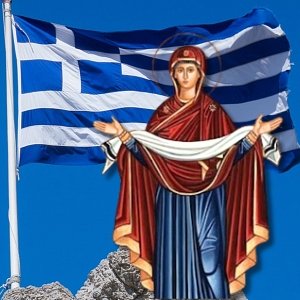
At the time that Leo the Great (A.D. 457-474) was king, saint Andrew the Fool-for-Christ lived in Constantinople. A night οf vigil in the temple of Our Lady of Blachernae, Saint Andreas, together with his student Epiphanius, who later became a patriarch of Constantinople (520-536 AD), saw the Holy Mother of God clearly visible, coming from the central gate of the temple. On the side of Holy Mother of God was a multitude of angels, and the virgins John the Forerunner and John the Theologian.
The miraculous icon of the Virgin Eleousa was hidden, at a depth of one and a half meters under the ground over centuries and found in a miraculous way. The Holy Mother of God appeared to the eight-year-old Athanasius Syros, while he was playing with other children on a hillside. She appeared to him as an unknown woman, who was dressed in black and barefoot, to make repentance. Despite the fact that the place was dry, it became soft and sank like the dough, because of the repentance of the unknown woman. At the three spots, where the woman worshiped, the ground started producing a sweet sense. However, no one believed what the little Athanasius experienced.
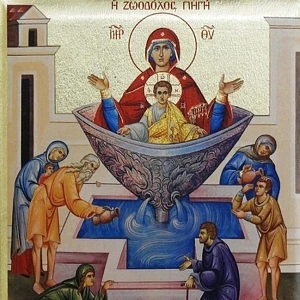
The miraculous water of the Holy Temple's Spring performed significant miracles, offering all kinds of healing. As a result, even Turkish residents visited it to avail themselves of its benefits. Unfortunately, the Temple was destroyed by the Turks, but it was later rebuilt around 1830 AD into a larger Temple. It was named the Life-Giving Spring of Balιkli, or Panagia of Balukhli, or Virgin Mary of the Spring, or Zoödochos Pege (Greek: Ζωοδόχος Πηγή) including the monastery, the church, and the holy spring. The term "Balik" in "Balıklı" originates from the Turkish word for ‘fish’.
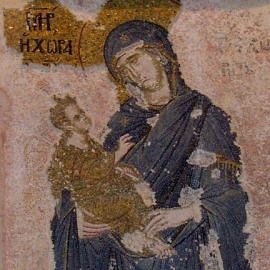
In Constantinople is located the ‘Monastery of Chora’ (or Khora), as it is named, dedicated to our Lord Jesus Christ. According to tradition, the monastery took its name from the area where it was built, which was called Chora/Khora and lay outside the walls of Constantinople. The monastery's cathedral was built upon an older structure, approximately between 1077 and 1081, by Maria Doukaina, who was the mother-in-law of Emperor Alexios I Komnenos. In 1120, Alexios' son, the sebastokrator Isaac Komnenos, carried out a complete restoration of the church. During the years 1316 and 1321 AD, Theodore Metochites, a venerable Logothete of the General under Andronikos II Palaiologos and a scholar with significant literary writings, undertook the renovation of the church. He added the southern chapel, covering all expenses himself and adorned the church with mosaics and mural paintings.
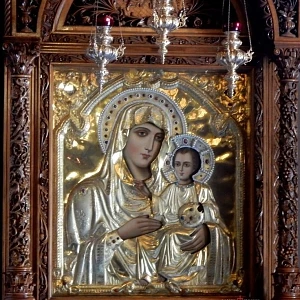
The holy icon of the Panagia Ierosolymitissa is found in the Holy Shrine of the Historical Monument of Gethsemane. This place is the empty tomb of Our Lady, known as the Kenotaphios (empty tomb), since her body was taken up in Heaven on the third day of her Dormition and is capable of performing miracles. The miracles of the holy icon are innumerable wherever it was found. The miraculous icon has traveled to several parts of Greece for veneration, while a faithful copy of it can be found in the town of Jenisea in Xanthi.
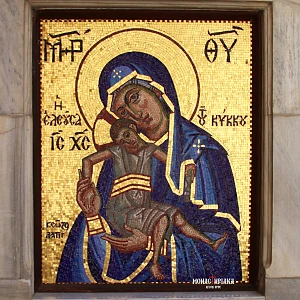
The miraculous icon of the Virgin Mary of Kykkos is the work of the Evangelist Luke and stands as one of the paramount pilgrimages of Cyprus and the entire Orthodoxy. The name of the Virgin of Kykkos derives from the Kykkos Monastery, to which she belongs today. The Patriarchal Stavropegic Monastery is situated on the western side of the Troodos mountain range, 18 kilometers from Mount Olympus, at an elevation of 1200 meters. The Kykkos Monastery serves as the "Residence" of the Virgin Mary of Kykkotissa, whose presence is felt through her numerous miracles.
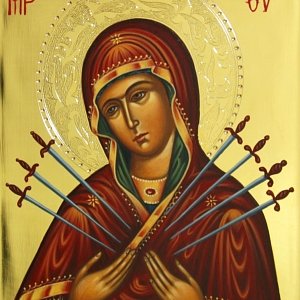
According to Orthodox tradition, the icon of our Lady of Sorrows is associated with the prophecy of the Righteous Simeon, as recorded by the Evangelist Luke: "...yea, a sword shall pierce through thy own soul also..." (Luke 2:35). The prophecy refers to the pain that the Virgin Mary would experience at the moment of separation from her beloved Son, when He would be crucified in front of her eyes. In the icon of the Virgin Mary with the Seven Swords, the infinite pain of her heart and the sorrow that the Ever-Virgin Mary suffered during her earthly journey, are depicted. The fullness of the grief and anguish that she endured, emanates from the Passion of Jesus Christ, as well as His Crucifixion.
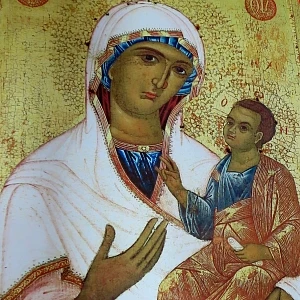
The Virgin Mary of the Vine is particularly beloved by all inhabitants of Lemnos island.The residents of the island recognize the miracles that were performed by the Virgin Mary through her white veil and show reverence to her as the Virgin of their land. She has performed many miracles, which are affirmed by the island's residents to this day. She protects the entire world, focusing on young children and adults that are facing health issues and other difficulties.
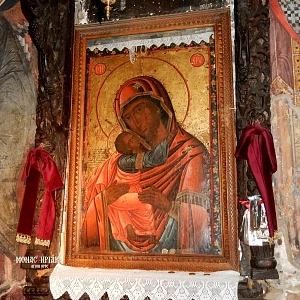
The Virgin Mary of Consolation is the most important and renowned Byzantine church in the prefecture of Arta, Epirus, Greece. It was built in the 13th century by Nikephoros I Komnenos Doukas, during the peak of the Despotate of Epirus. The church is dedicated to the Annunciation of the Theotokos, and evidence show that in the 16th century, it served as the catholikon of a women's monastery. Additionally, a distinguishing feature of the church, which renders it a masterpiece of Byzantine art, is its' dome that is like hanging from the sky. To this day, it maintains its uniqueness and innovation, while it impresses and astonishes with its rich interior, which consists of ornate sculptures, frescoes and mosaics.
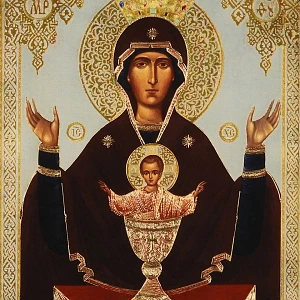
The miraculous icon of Our Lady resided for many years in a province in Russia, but it was not yet known by the name «Inexhaustible Cup of Life». A remarkable event changed the course of this holy icon and revealed its Divine grace. In the Efremovskaya district of the Tula province in Russia, a retired soldier named Stefan, lived there. This man suffered from the vice of drinking alcohol. His dependence on alcohol led him to squander all his possessions and fall into a pitiable condition. However, one night Stefan had an extraordinarily unusual dream that deeply shook him.
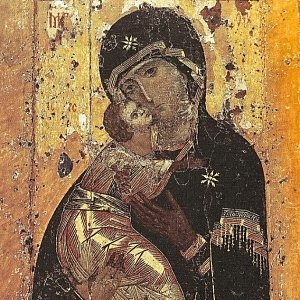
The miraculous icon of our Lady of Vladimir is one of the most well-known and beloved icons throughout Russia. It holds significant historical and cultural value, with its connection to the Russian people dating back to the earliest centuries of its history. In the 12th century, Patriarch Luke Chrysoberges of Constantinople (1157-1169) offered the icon of the Theotokos to Duke Yuri Vladimirovich Dolgorukov as a wedding gift. The prince received the precious icon and kept it in the women's monastery of Vyshgorod. In the year 1155, Prince Andrey Bogolybsky transferred the holy icon to the city of Vladimir in Russia. This event led to the construction of a magnificent cathedral dedicated to the Dormition of the Theotokos, where the miraculous icon was to be enshrined.